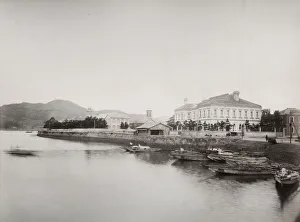Dejima Collection
Dejima: A Window into Japan's Foreign Connections Step back in time to the late 19th century with a captivating photograph of Dejima
All Professionally Made to Order for Quick Shipping
Dejima: A Window into Japan's Foreign Connections Step back in time to the late 19th century with a captivating photograph of Dejima, a foreign settlement nestled in Nagasaki, Japan. This unique island served as a crucial link between Japan and the outside world during an era of isolation. As you explore historical engravings and silk paintings depicting Dejima, it becomes evident that this tiny landmass played a significant role in shaping international relations. The bustling Nagasaki harbor surrounding Dejima was witness to countless interactions between cultures, fostering trade and exchange. Vue de Decima, fac-simile d'un plan hollandais published by Levyssohn offers us a glimpse into the layout of this intriguing settlement. Known as "The Island of Decima, " it stood proudly amidst the Bay of Nagasaki like a bridge connecting two worlds. Children swimming off the shores circa 1890 reminds us that even within this foreign enclave, life continued with its own rhythm. These young souls embraced their surroundings despite being surrounded by unfamiliar faces and customs. Dutch VOC employees from centuries past come alive through vivid woodblock prints. Their presence serves as a testament to the enduring connection between nations long before globalization became commonplace. Dejima stands as an emblematic symbol of cultural integration and understanding. It represents both Japan's willingness to engage with foreign powers and their desire for self-preservation during times when isolationism prevailed. Intriguingly captured in photographs from around 1880s-1890s, we witness glimpses of daily life within this vibrant community—a melting pot where diverse nationalities coexisted harmoniously against all odds. Bunkindo's print showcasing foreign ships docked at Nagasaki port (1800-1850) transports us back to an era when maritime trade flourished under Dejima's watchful eye—an economic lifeline for both local merchants and foreign traders.

















